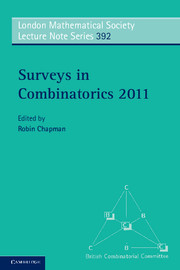Book contents
- Frontmatter
- Contents
- Preface
- 1 Counting planar maps, coloured or uncoloured
- 2 A survey of PPAD-completeness for computing Nash equilibria
- 3 Hypergraph Turán problems
- 4 Some new results in extremal graph theory
- 5 The cyclic sieving phenomenon: a survey
- 6 Order in building theory
- 7 Graphs, colours, weights and hereditary properties
- 8 Random geometric graphs
- 9 Transversals in latin squares: a survey
1 - Counting planar maps, coloured or uncoloured
Published online by Cambridge University Press: 05 August 2011
- Frontmatter
- Contents
- Preface
- 1 Counting planar maps, coloured or uncoloured
- 2 A survey of PPAD-completeness for computing Nash equilibria
- 3 Hypergraph Turán problems
- 4 Some new results in extremal graph theory
- 5 The cyclic sieving phenomenon: a survey
- 6 Order in building theory
- 7 Graphs, colours, weights and hereditary properties
- 8 Random geometric graphs
- 9 Transversals in latin squares: a survey
Summary
Abstract
We present recent results on the enumeration of q-coloured planar maps, where each monochromatic edge carries a weight v. This is equivalent to weighting each map by its Tutte polynomial, or to solving the q-state Potts model on random planar maps. The associated generating function, obtained by Olivier Bernardi and the author, is differentially algebraic. That is, it satisfies a (nonlinear) differential equation. The starting point of this result is a functional equation written by Tutte in 1971, which translates into enumerative terms a simple recursive description of planar maps. The proof follows and adapts Tutte's solution of properly q-coloured triangulations (1973-1984).
We put this work in perspective with the much better understood enumeration of families of uncoloured planar maps, for which the recursive approach almost systematically yields algebraic generating functions. In the past 15 years, these algebraicity properties have been explained combinatorially by illuminating bijections between maps and families of plane trees. We survey both approaches, recursive and bijective.
Comparing the coloured and uncoloured results raises the question of designing bijections for coloured maps. No complete bijective solution exists at the moment, but we present bijections for certain specialisations of the general problem. We also show that for these specialisations, Tutte's functional equation is much easier to solve that in the general case.
We conclude with some open questions.
Introduction
A planar map is a proper embedding in the sphere of a finite connected graph, defined up to continuous deformation.
Information
- Type
- Chapter
- Information
- Surveys in Combinatorics 2011 , pp. 1 - 50Publisher: Cambridge University PressPrint publication year: 2011
Accessibility standard: Unknown
Why this information is here
This section outlines the accessibility features of this content - including support for screen readers, full keyboard navigation and high-contrast display options. This may not be relevant for you.Accessibility Information
- 5
- Cited by
